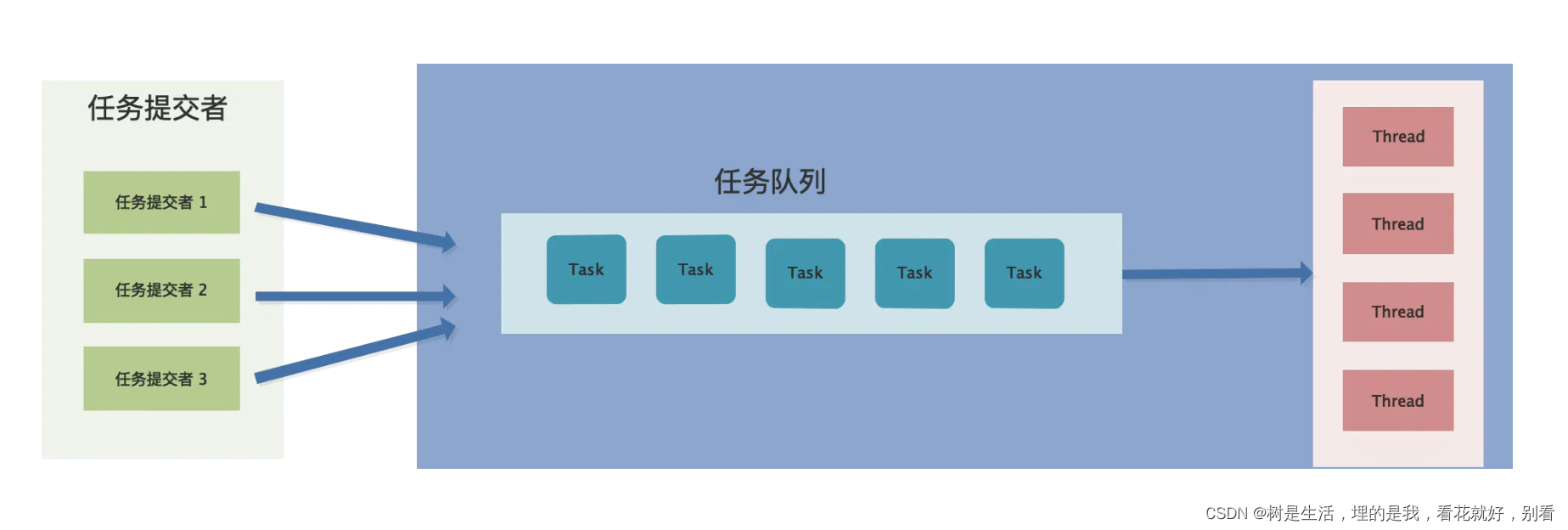线程是进程中的⼀个执⾏单元,负责当前进程中程序的执⾏,⼀个进程中⾄少有⼀个线程。⼀个进程中是可以有多个线程的,这个应⽤程序也可以称之为多线程程序。多线程程序作为一种多任务、并发的工作方式
并发与并⾏
早期计算机的 CPU 都是单核的,一个 CPU 在同一时间只能执行一个进程/线程,当系统中有多个进程/线程等待执行时,CPU 只能执行完一个再执行下一个。为了提高 CPU 利用率,减少等待时间,人们提出了一种 CPU 并发工作的理论.
并发:指两个或多个事件在同⼀个时间段内发⽣,当系统中有多个进程/线程等待执行时,CPU只能执行完一个再执行下一个。
并⾏:指两个或多个事件在同⼀时刻发⽣(同时发⽣),多核 CPU 的每个核心都可以独立地执行一个任务,而且多个核心之间不会相互干扰。在不同核心上执行的多个任务,是真正地同时运行,这种状态就叫做并行。。
顾名思义:线程池就是线程的池子,有很多线程,但是数量不会超过池子的限制。需要用到多执行流进行任务出路的时候,就从池子中取出一个线程去处理,线程池就类似于一个实现了消费者业务的生产者与消费者模型。
本质上:这就是一个基于生产者消费者模型来实现的线程池,那么同样遵守三种规则,生产者和生产者之间存在互斥,处理任务的线程之间存在互斥关系,生产者和消费者之间存在同步和互斥关系
线程池维护者多个线程,等待着分配可并发执行的任务,可以避免在短时间创建和销毁大量线程带来时间成本。
总结为三点:
1.避免线程因为不限制创建数量导致的资源耗尽风险
2.任务队列缓冲任务,支持忙线不均的作用
3.节省了大量频繁创建/销毁线程的时间成本
下面展示一些 threadpool实现,源码来自openharmony。

/*
* Copyright (c) 2022 Huawei Device Co., Ltd.
* Licensed under the Apache License, Version 2.0 (the "License");
* you may not use this file except in compliance with the License.
* You may obtain a copy of the License at
*
* http://www.apache.org/licenses/LICENSE-2.0
*
* Unless required by applicable law or agreed to in writing, software
* distributed under the License is distributed on an "AS IS" BASIS,
* WITHOUT WARRANTIES OR CONDITIONS OF ANY KIND, either express or implied.
* See the License for the specific language governing permissions and
* limitations under the License.
*/
#ifndef NETSTACK_THREAD_POOL
#define NETSTACK_THREAD_POOL
#include <atomic>
#include <condition_variable>
#include <queue>
#include <thread>
#include <vector>
namespace OHOS::NetStack {
template <typename Task, const size_t DEFAULT_THREAD_NUM, const size_t MAX_THREAD_NUM> class ThreadPool {
public:
/**
* disallow default constructor
*/
ThreadPool() = delete;
/**
* disallow copy and move
*/
ThreadPool(const ThreadPool &) = delete;
/**
* disallow copy and move
*/
ThreadPool &operator=(const ThreadPool &) = delete;
/**
* disallow copy and move
*/
ThreadPool(ThreadPool &&) = delete;
/**
* disallow copy and move
*/
ThreadPool &operator=(ThreadPool &&) = delete;
/**
* make DEFAULT_THREAD_NUM threads
* @param timeout if timeout and runningThreadNum_ < DEFAULT_THREAD_NUM, the running thread should be terminated
*/
explicit ThreadPool(uint32_t timeout) : timeout_(timeout), idleThreadNum_(0), needRun_(true)
{
for (int i = 0; i < DEFAULT_THREAD_NUM; ++i) {
std::thread([this] { RunTask(); }).detach();
}
}
/**
* if ~ThreadPool, terminate all thread
*/
~ThreadPool()
{
// set needRun_ = false, and notify all the thread to wake and terminate
needRun_ = false;
while (runningNum_ > 0) {
needRunCondition_.notify_all();
}
}
/**
* push it to taskQueue_ and notify a thread to run it
* @param task new task to Execute
*/
void Push(const Task &task)
{
PushTask(task);
if (runningNum_ < MAX_THREAD_NUM && idleThreadNum_ == 0) {
std::thread([this] { RunTask(); }).detach();
}
needRunCondition_.notify_all();
}
private:
bool IsQueueEmpty()
{
std::lock_guard<std::mutex> guard(mutex_);
return taskQueue_.empty();
}
bool GetTask(Task &task)
{
std::lock_guard<std::mutex> guard(mutex_);
// if taskQueue_ is empty, means timeout
if (taskQueue_.empty()) {
return false;
}
// if run to this line, means that taskQueue_ is not empty
task = taskQueue_.top();
taskQueue_.pop();
return true;
}
void PushTask(const Task &task)
{
std::lock_guard<std::mutex> guard(mutex_);
taskQueue_.push(task);
}
class NumWrapper {
public:
NumWrapper() = delete;
explicit NumWrapper(std::atomic<uint32_t> &num) : num_(num)
{
++num_;
}
~NumWrapper()
{
--num_;
}
private:
std::atomic<uint32_t> &num_;
};
void Sleep()
{
std::mutex needRunMutex;
std::unique_lock<std::mutex> lock(needRunMutex);
/**
* if the thread is waiting, it is idle
* if wake up, this thread is not idle:
* 1 this thread should return
* 2 this thread should run task
* 3 this thread should go to next loop
*/
NumWrapper idleWrapper(idleThreadNum_);
(void)idleWrapper;
needRunCondition_.wait_for(lock, std::chrono::seconds(timeout_),
[this] { return !needRun_ || !IsQueueEmpty(); });
}
void RunTask()
{
NumWrapper runningWrapper(runningNum_);
(void)runningWrapper;
while (needRun_) {
Task task;
if (GetTask(task)) {
task.Execute();
continue;
}
Sleep();
if (!needRun_) {
return;
}
if (GetTask(task)) {
task.Execute();
continue;
}
if (runningNum_ > DEFAULT_THREAD_NUM) {
return;
}
}
}
private:
/**
* other thread put a task to the taskQueue_
*/
std::mutex mutex_;
std::priority_queue<Task> taskQueue_;
/**
* 1 terminate the thread if it is idle for timeout_ seconds
* 2 wait for the thread started util timeout_
* 3 wait for the thread notified util timeout_
* 4 wait for the thread terminated util timeout_
*/
uint32_t timeout_;
/**
* if idleThreadNum_ is zero, make a new thread
*/
std::atomic<uint32_t> idleThreadNum_;
/**
* when ThreadPool object is deleted, wait until runningNum_ is zero.
*/
std::atomic<uint32_t> runningNum_;
/**
* when ThreadPool object is deleted, set needRun_ to false, mean that all thread should be terminated
*/
std::atomic_bool needRun_;
std::condition_variable needRunCondition_;
};
} // namespace OHOS::NetStack
#endif /* NETSTACK_THREAD_POOL */这份源码的实现,没有使用一些较难理解的语法,基本上就是使用线程+优先级队列实现的。提前创建指定数目的线程,每次取一个任务并执行。任务队列负责存放线程需要处理的任务,工作线程负责从任务队列中取出和运行任务,可以看成是一个生产者和多个消费者的模型。
#include "doctest.h"
DOCTEST_MAKE_STD_HEADERS_CLEAN_FROM_WARNINGS_ON_WALL_BEGIN
#include <stdexcept>
DOCTEST_MAKE_STD_HEADERS_CLEAN_FROM_WARNINGS_ON_WALL_END
//#define DOCTEST_CONFIG_IMPLEMENT_WITH_MAIN
//#define DOCTEST_CONFIG_DISABLE
#include <string>
#include <iostream>
#include "thread_pool.h"
//
// Created by Administrator on 2022/8/10.
//
class Task {
public:
Task() = default;
explicit Task(std::string context){
mContext = context;
}
bool operator<(const Task &e) const{
return priority_ < e.priority_;
}
void Execute(){
std::lock_guard<std::mutex> guard(mutex_);
std::cout << "task is execute,name is:"<<mContext<<std::endl;
}
public:
uint32_t priority_;
private:
std::string mContext;
static std::mutex mutex_;
};
#define DEFAULT_THREAD_NUM 3
#define MAX_THREAD_NUM 6
#define TIME_OUT 500
std::mutex Task::mutex_;
static int threadpoolTest(){
static OHOS_NetStack::ThreadPool<Task, DEFAULT_THREAD_NUM, MAX_THREAD_NUM> threadPool_(TIME_OUT);
Task task1("name_1");
Task task2("name_2");
Task task3("name_3");
Task task4("name_4");
threadPool_.Push(task1);
threadPool_.Push(task2);
threadPool_.Push(task3);
threadPool_.Push(task4);
return 0;
}
TEST_CASE("threadPool simple use example, test by doctest unit tool") {
threadpoolTest();
}以上该版本thread_pool的简单使用示例,可以看到使用稍微麻烦了些。必须定义格式如下的task类,必须实现operator<和Execute()方法,不过整体实现还是很不错的,通俗易懂!
线程池的应用场景:当有大量的数据请求,需要多执行流并发/并行处理时,可以采用线程池来处理任务,可避免大量线程频繁创建或销毁所带来的时间成本,也可避免在峰值压力下,系统资源耗尽的风险。